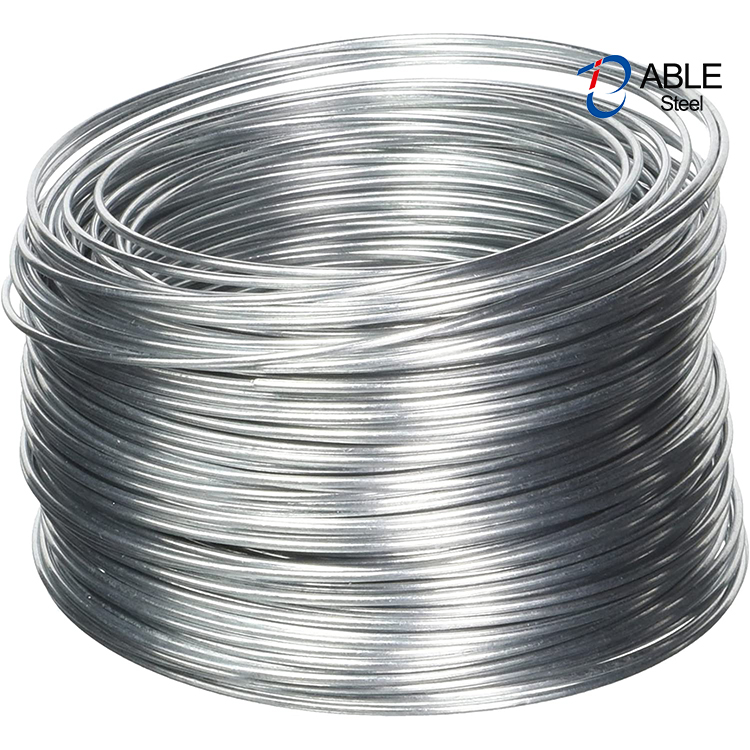The production process of Stainless Steel Wire involves several steps, including melting, casting, hot rolling, cold drawing, and annealing. Here is a detailed explanation of each step: 1. Melting: The first step in the production process is melting the raw materials, which typically include iron ore, chromium, nickel, and other alloying elements. These materials are melted in an electric arc furnace or an induction furnace at high temperatures. 2. Casting: Once the molten metal is ready, it is poured into molds to form billets or ingots. These molds are usually made of steel and have a specific shape and size. The molten metal is allowed to solidify and cool down in the molds. 3. Hot Rolling: The solidified billets or ingots are then heated to a high temperature and passed through a series of rolling mills. The rolling mills reduce the thickness and width of the metal by applying pressure and compressing it between rotating rolls. This process is called hot rolling and helps to refine the grain structure and improve the mechanical properties of the metal. 4. Cold Drawing: After hot rolling, the stainless steel wire is further processed through a cold drawing process. In this step, the wire is pulled through a series of dies or draw plates to reduce its diameter and increase its length. The wire is lubricated to reduce friction during the drawing process and ensure a smooth surface finish. 5. Annealing: The cold-drawn wire is then subjected to an annealing process, which involves heating it to a specific temperature and holding it there for a certain period of time. Annealing helps to relieve internal stresses in the wire and improve its ductility and toughness. It also helps to refine the grain structure and enhance the corrosion resistance of the stainless steel. 6. Surface Treatment: Once the wire has been annealed, it may undergo surface treatments such as pickling, passivation, or electro-polishing to remove any oxide scale or contaminants and improve its appearance and corrosion resistance. 7. Coiling and Packaging: Finally, the stainless steel wire is coiled onto spools or reels and packaged for shipment or further processing. The wire is typically measured and cut to a specific length before coiling to meet customer requirements. Stainless steel wire has a wide range of applications due to its unique properties and characteristics. Some common applications of stainless steel wire include:
1. Construction: Stainless steel wire is widely used in the construction industry for various purposes such as reinforcing concrete structures, fence, and WIRE MESH for walls and ceilings. 2. Automotive industry: Stainless steel wire is used in the automotive industry for manufacturing springs, cables and wire harnesses. It is also used for welding purposes in the fabrication of exhaust systems and other components. 3. Aerospace industry: Stainless steel wire is used in the aerospace industry for manufacturing aircraft cables, springs, and wire mesh for filtration systems. Its high strength and corrosion resistance make it suitable for demanding aerospace applications. 4. Medical industry: Stainless steel wire is used in the medical industry for manufacturing surgical instruments, orthopedic implants, and medical devices. Its biocompatibility, high strength, and resistance to corrosion make it ideal for these applications. 5. Food processing industry: Stainless steel wire is widely used in the food processing industry for manufacturing conveyor belts, sieves, and screens. Its hygienic properties, resistance to corrosion, and ease of cleaning make it suitable for use in food processing environments. 6. Marine industry: Stainless steel wire is extensively used in the marine industry for manufacturing rigging components, fishing nets, and marine hardware. Its high resistance to corrosion in saltwater environments makes it ideal for marine applications. 7. Electronics industry: Stainless steel wire is used in the electronics industry for manufacturing connectors, springs, and electrical contacts. Its high electrical conductivity and corrosion resistance make it suitable for these applications. 8. Art and craft: Stainless steel wire is used by artists and craftsmen for creating sculptures, jewelry, and decorative items. Its malleability, strength, and resistance to corrosion make it a popular choice for artistic and creative purposes. Overall, the production process of stainless steel wire involves melting the raw materials, casting the molten metal into billets or ingots, hot rolling to reduce the thickness and width, cold drawing to further reduce the diameter and increase the length, annealing to improve the properties, surface treatment for enhanced corrosion resistance, and coiling and packaging for shipment.


